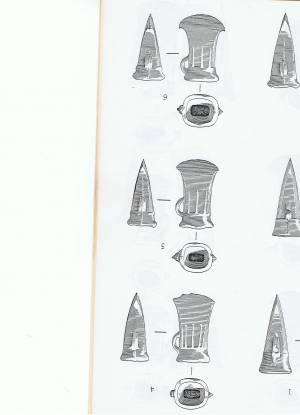|
| *****SWAAG_ID***** | 517 |
| Date Entered | 08/05/2012 |
| Updated on | 08/05/2012 |
| Recorded by | Tim Laurie |
| Category | Archaeological Find |
| Record Type | Northern Britain |
| SWAAG Site Name | |
| Site Type | |
| Site Name | |
| Site Description | |
| Site Access | Private |
| Record Date | 29/04/2012 |
| Location | Gilmonby |
| Civil Parish | Not known |
| Brit. National Grid | Hidden |
| Altitude | |
| Geology | |
| Record Name | Swaag in Eden 8. Hoard of Late Bronze Age Metalwork from Gilmonby |
| Record Description | A total of 127 objects (including copper based metal objects, copper ingot fragments and six ferrous metal objects) were found in the course of excavation of the site after initial discovery of a spearhead by the farmer during field drainage operations.
This significant hoard is interpreted as a smith's hoard.
The fidsite is in a wet pasture to the south of the River Greta on the line of the direct route from the South and East (from the Vale of Mowbray) to the north and west (to the Vale of Eden) and is interpreted as confirming the existence of a trackway on the eastern approaches to the Stainmore Pass. This trackway, crossing Gayles Moor, Barningham Moor and Scargill Moor, survived as the route taken by Scots Raiders, as a drove road for cattle from Galloway to the Markets of the South, and for Travelling Tinkers through post medieval time as the Badger Way. |
| Dimensions | See Coggins and Tylecote 1983. |
| Geographical area | |
| Species | |
| Scientific Name | |
| Common / Notable Species | |
| Tree and / or Stem Girth | |
| Tree: Position / Form / Status | |
| Tree Site ID | 0 |
| Associated Site SWAAG ID | 0 |
| Additional Notes | During our visit to the Roman Fort and to the Norman Keep at Bowes, much discussion was centred on the existence of a Cross-Pennine route across Stainmore and that the eastern approach to this trackway followed the southern edge of the Tees Valley to join the line taken by the Roman Dere Street from Scotch Corner.
The evidence for Roman and Norman Occupation at Bowes is of course most prominent but their is much evidence for the existence of a prehistoric route 66 also, but on a more direct and different line.
For an account of the circumstances of the finding of the Gilmonby Hoard, for very fine drawings of all the objects, and for an account of the metallurgy represented by the objects, see Coggins, D.and Tylecote, R.F. 1983. 'Hoard of Late Bronze Age Metalwork from Gilmonby'. The Bowes Museum. Archaeological Reports, Volume 2. |
| Image 1 ID | 2823 Click image to enlarge |
| Image 1 Description | |  |
| Image 2 ID | 2824 Click image to enlarge |
| Image 2 Description | Example page of the objects illustrated (Drawings by Sandy Morris and Alan Dyson). |  |
| Image 3 ID | 2826 Click image to enlarge |
| Image 3 Description | Example page of the objects illustrated (Drawings by Sandy Morris and Alan Dyson). |  |
| Image 4 ID | 2827 Click image to enlarge |
| Image 4 Description | Example page of the objects illustrated (Drawings by Sandy Morris and Alan Dyson). |  |
| Image 5 ID | 2828 Click image to enlarge |
| Image 5 Description | Example page of the objects illustrated (Drawings by Sandy Morris and Alan Dyson). |  |
| Image 6 ID | 2831 Click image to enlarge |
| Image 6 Description | Notes on the use of iron files to remove casting ridges and on hollow gound edges implying use of the wheel.
If the writer of these notes contacts me I shall be grateful, as the notes are not signed! |  |





